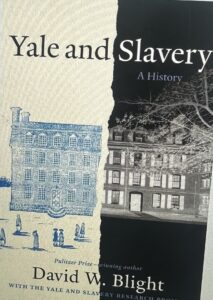Paul O’Connor, longtime newspaper journalist, reviews a history of Yale University’s relationship with the institution of slavery, the result of an academic investigation.
Reviewed by Paul T. O’Connor
YALE AND SLAVERY: A History. By David Blight and the Yale and Slavery Research Project. Yale Press. 448 pages. $35, hardcover. Audiobook also from Yale Press, read by Simon Kerr, 17 hours, 31 minutes., $17.74 on Audible.
 As a boy growing up in New Haven, Conn., I visited the Yale University campus regularly. I attended my first rock concert in Woolsey Hall, snuck into football games at the Yale Bowl and suffered my most humiliating defeat as a high school swimmer in the 100-yard butterfly against the Yale freshman team in the Payne Whitney Gymnasium pool.
As a boy growing up in New Haven, Conn., I visited the Yale University campus regularly. I attended my first rock concert in Woolsey Hall, snuck into football games at the Yale Bowl and suffered my most humiliating defeat as a high school swimmer in the 100-yard butterfly against the Yale freshman team in the Payne Whitney Gymnasium pool.
Yale sits in the center of downtown, and I walked through campus almost every school day, often reading the inscriptions that honor the building benefactors.
As a high school senior, I wasn’t smart enough to get into Yale, but I was smart enough not to suffer the indignity of applying and being rejected, especially after getting lapped in that butterfly event by two Olympic hopefuls.
All of this is the long way of saying that I hold much affinity to the school and should be considered a subway alumnus. And that’s why I bought and listened to the David Blight’s book reporting the findings of Yale’s investigation into its many connections to slavery.
To understand Yale’s ties to slavery, one must first understand that the Puritans and Congregationalists who founded the New Haven colony as probably the most conservative in New England were products of a culture that found slavery natural. They liberally preached a duty, however, to treat enslaved persons well; brutality towards slaves was sinful.
New Haven, a busy port, carried on much trade with the slave colonies of the Caribbean and profited mightily from slavery without factoring the colony’s relatively small enslaved population. The men who founded Yale in 1701 were mostly slaveholders, and through the years leading up to the Civil War, many Yale leaders either owned enslaved people or openly supported the institution of slavery in their preaching and scholarship. Until Connecticut fully banned slavery in 1848, Southern students brought along their slaves to serve as personal servants.
In the years leading up to war, Yale was divided over the abolition question. In large part, sympathy for slavery arose from Yale’s fairly large Southern population of alumni, students and influential faculty. Many of those buildings I so admired as a child were named after slaveholders, and the Calhoun residence building was named after South Carolina’s Sen. John C. Calhoun, the nation’s seventh vice president.
Even among Northern-born and raised Yalies, there was sympathy for slavery, several of them moving south to support the Confederacy.
Pre-war, Yale had educated several African Americans, and the school employed many African Americans, mostly in custodial work but at least one in scientific research.
At the same time, supporters of abolition likely outnumbered supporters of slavery. Most notable among these was Dwight Woolsey – see reference to the concert hall above – the college president from 1846 through 1871. He strongly supported abolition. After the war’s outbreak, Southern students left, and the campus was mostly home to Northern students who conveniently paid others to fight in their place. Many other students and alumni joined the Union army, and a number died in combat.
The book should bear a longer title: Yale, Slavery and the Post-War Whitewashing of Jim Crow. In efforts to reestablish itself as a national institution, to welcome back Southern alumni and to appeal to Southern students, Yale supported reconciliation between North and South – a good thing but in a bad way, by embracing The Lost Cause nonsense, which applied concepts of honor and justice to the Southern campaign to keep people enslaved. Yale went so far as to heap great praise on Robert E. Lee and Stonewall Jackson in the early 20th century at the same time it ignored the South’s epidemic of lynchings.
Yale and Slavery is just one of what will be a number of self-studies American universities conduct to trace their own participation in slavery. The closets of many of the nation’s oldest, and often most prestigious, universities contain ghosts that will come to life.
David Blight is an academic, and his assignment from the university was to document Yale’s full history regarding slavery. He probably did that and led the way for other scholars who will probe some of the project’s findings more deeply. The book, therefore, is quite long and, had it been intended for a popular history audience, it might have been shortened significantly. I doubt, however, that anyone will accuse him of having sugarcoated Yale’s involvement. To his credit, it’s readable, not turgid.
Simon Kerr’s reading of the book, on the other hand, grated on my New Haven-born ears. His pronunciation of names associated with Yale, New Haven and one local Italian family is astonishingly bad.